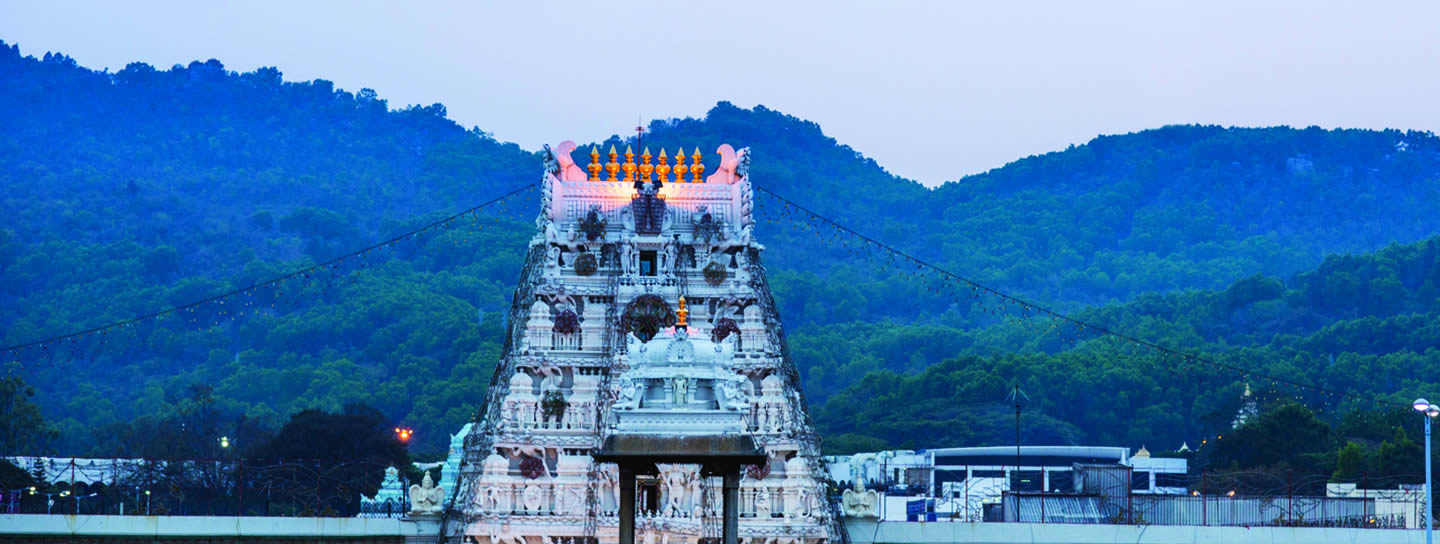Tirupati-Tirumala
Daiwik Hotels welcomes you to one of the most famous Hindu pilgrimages in India, the sacred abode of Lord Venkateswara, the Lord of Tirupati-Tirumala.
We are delighted to inform you that Daiwik Hotels, TIRUPATI will be at your service in the near future. Meanwhile we are placing this information on our website for the benefit of pilgrims travelling to the sacred home of Lord Venkateswara.
The temple of Lord Venkateswara is one of the holiest pilgrimages of Lord Vishnu. The temple stands on the Venkachala Hill which is the highest peak of the seven sacred hills of Tirumala called Saptagiri. The hills, river and the temple are celebrated in many mythological stories found in the Venkatachala Mahatmya and many Puranas like the Varaha Purana and the Bhavishyottara Purana.
Lord Venkateswara is also called Balaji and Srinivas by his devotees. This ancient temple has called pilgrims from across the land and beyond the seas to its golden doors for centuries. It has seen kings and preachers, singers and poets, the rich and the poor stand at the threshold of the sanctum with folded hands. And the benign Lord listens to all their prayers.
The Venkateswara Temple is in Chittoor District of Andhra Pradesh, not far from the border with Tamil Nadu. It is 550 km from Hyderabad, 250 km from Bangalore and 150 km from Chennai.
The location is often referred to as Tirupati-Tirumala but they are not the same place. The temple is at Tirumala and the nearest town is Tirupati
Tiru means sacred and mala means hill and this complex of temples and other buildings stands on top of the Venkatachala or Venkatagiri Hill. To reach the temple is a journey of 20 km up a picturesque hill road starting from Adagiri. The temple stands on the Venkatachala Hill, the highest peak of the Saptagiri Range at a height of 853 metres (2799 feet). Tirupati is the nearest town 3 kilometres away. There are very good roads connecting Tirupati to Tirumala and it is well connected by cars and buses.
Some devotees prefer to walk up the hill road as a part of their pilgrimage.
Hindus believe in the holy trinity of gods – Brahma, Vishnu and Shiva. Brahma is the creator of the universe and at the end of its cycle it is Shiva who destroys it all so that creation can start again. It is Vishnu as the preserver of all creation who plays the most vital role. He protects and preserves life, maintains the sacred laws of Dharma and listens to the prayers of his devotees with kindness and compassion.
Lord Venkateswara of Tirumala is one of the aspects of Lord Vishnu. Traditionally the pilgrimages of Vishnu are called Divya Desams and there are 108 such shrines. Tirumala is one of the most sacred. Here the beautiful image of Lord Venkateswara stands in the lamp lit garbha griha, the sanctum sanctorum, wreathed in incense, glittering in silk garments, gold and jewels as the air reverberates with prayers and the clanging of bells. The call of this deity is eternal
Daiwik Hotels Comes to Tirupati
At our upcoming, Daiwik Hotels Tirupati, we aim to make your tirtha a complete spiritual experience. During your stay with us, we will take care of all your requirements, making sure your journey is a time of both spiritual joy and serenity.
There are seven peaks in the Saptagiri range that are said to be the seven heads of Adishesha, the divine serpent of Lord Vishnu
The god is often depicted lying on the coils of Adishesha, with the seven hoods of the snake flaring above him, as he rests on the waters of Ananta, the celestial ocean in his heaven Vaikuntha. Today the seven peaks are called Seshadri, Neeladri, Garudadri, Anjanadri, Vrishabhadri, Narayanadri and Venkatadri..
The temple stands on the highest peak of Venkadri or Venkatachala Hill.It is considered to be another Vaikuntha and there are many myths about this hill. In Hinduism, time has been divided into four ages or yugas and this hill has had a different name in every yuga. In the Krita Yuga it was called Vrishabhachala; in the Treta Yuga it was Anjalachala; in the Dvapara Yuga, Seshachala and the present Kali Yuga it is Venkatachala. And each yuga has its own fascinating mythology.
In the Krita Yuga, a demon named Vrishabhasura prayed and performed mighty penances until Vishnu finally granted him a boon. The demon said he wanted to face Vishnu in battle because he knew that anyone killed by Vishnu immediately gained salvation or moksha and his wish came true as Vishnu’s discuss cut off his head. The hill then was called Vrishabhachala.
Treta Yuga Anjanadevi, the wife of a tribal leader who lived by the banks of the Pampa River came here to pray to Vishnu for a son. She prayed for 12 years and lived on water and fruits brought by Vayu, the God of the Wind. Finally she was blessed with a son named Anjaneya. He was the son of Vayu and we know him as Hanuman. It is said that Lord Rama came here to meet Anjanadevi and bathed in the temple tank Swami Pushkarini. Thus the hill came to be called Anjalachala.
In the Dvapara Yuga , there was a mighty battle between Vayu, the God of the Wind and Adishesha, the divine serpent. Adishesha wrapped himself around the Ananda Mountain in Swarga and Vayu could not blow him away. All the worlds trembled as the battle would not end and finally Vishnu suggested that Adishesha should let Vayu win. At this the serpent stopped fighting and he and the hill were blown to earth. As Adishesha felt sad, Vishnu promised him that he would always reside on this hill which now came to be called Seshachala.
In the Kali Yuga Madhava, a young Brahmin, abandoned his parents, wife and child to live with another woman. He got leprosy and wandered about seeking salvation until he met a group of pilgrims going up the hill. He stood before the deity and begged for forgiveness for his sins and his body was covered in flames and he was cured. Venkata means the power to forgive sins and so the hill is now called Venkatachala.
There are many legends about how Vishnu came to stay on Venkatachala Hill. One of them is around his second avatar of Varaha, the boar. It is said in the Varaha Purana that 8000 yugas ago there was a great flood, a pralaya, and Prithvi, the Goddess Earth sank to the bottom of the ocean and it seemed as if creation had come to an end.
Whenever creation is threatened, Vishnu always comes to the rescue. He assumed the form of a boar and descended to the bottom of the ocean in search of Prithvi. Here, in the netherworld, called Patalaloka, he was attacked by a demon called Hiranyaksha and they fought a mighty battle. Varaha defeated the demon and then a triumphant god emerged from the ocean standing on the hood of the Adishesha and with Prithvi resting on his tusks.
Varaha decided to stay on earth and he chose the Venkatachala Hill as his earthly home. However as people were afraid of his form as a boar, he took the more benign form of Vishnu. So in the temple he stands holding the shankha (conch) and the chakra (discus), with his two consorts, Bhudevi and Sridevi beside him.
This myth of the Varaha avatar is connected to another myth about the building of the temple. It is said that when Venkateswara decided to build his temple, the land was given to him by Varaha. It is a bit confusing as both Venkateswara and Varaha are avatars of Vishnu but then faith needs no logic!
Vishnu the god of the Venkatachala Hill is thus called Lord Venkateswara (Lord of Venkatachala) and he is the destroyer of all sins and the generous giver of prosperity. He is called by many names by his devotees. He is Balaji as he floated on the ocean; Srinivasa as Lakshmi resides in his heart; Perumal, the Great Lord; Malaiyappa, Lord of the Hill; and Govinda, the divine Krishna.
For many devotees their pilgrimage includes walking up the Venkatachala Hill. The path is 11 km and begins at Adagiri from a gopuram gateway and a giant image of Hanuman. Almost the entire way the path is shaded from the sun and rain. The walk takes pilgrims past green forests and gardens and it is not too steep but it does mean up to four hours of walking. The area around the hill is now a wildlife preserve – the Shri Venkateswara Sanctuary & National Park. It has lush green forests, a beautiful variety of wild flowers and among the wild life there are deer, leopards and loris monkeys.
Many pilgrims who walk up the hill then choose to stay overnight at Tirumala and walk down the next day. There are very good arrangements for night stay and for keeping your luggage at the Central Reception Office.


